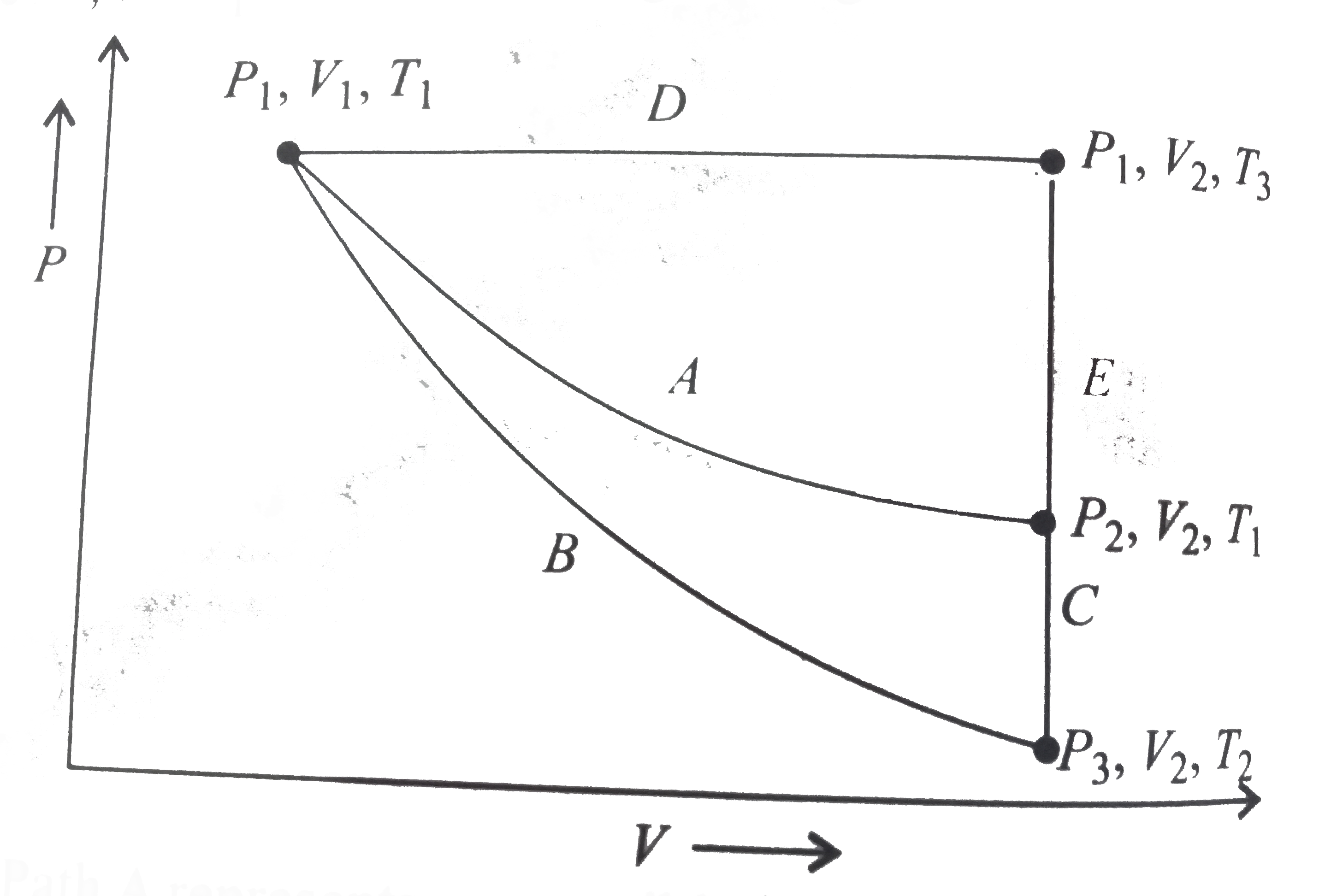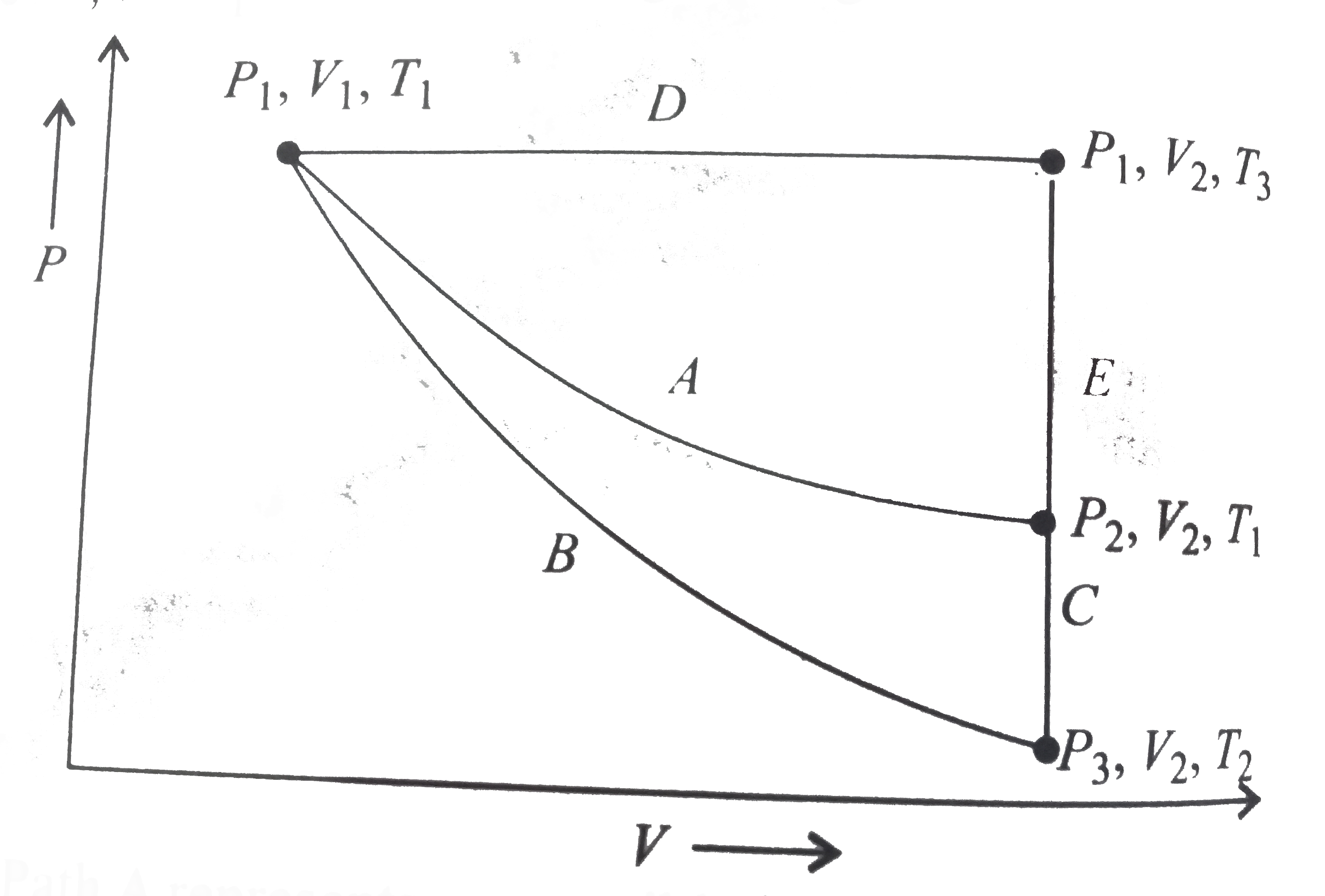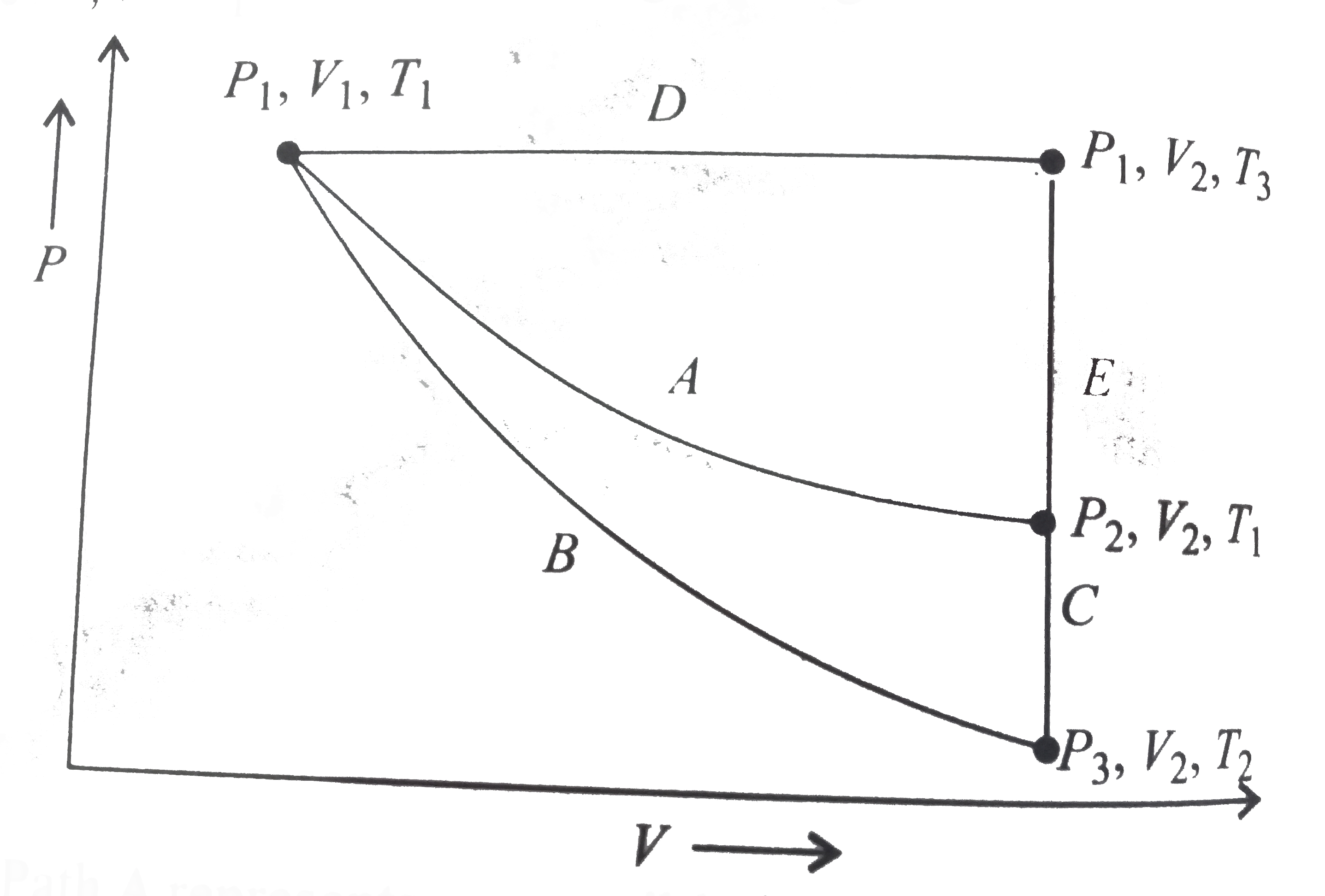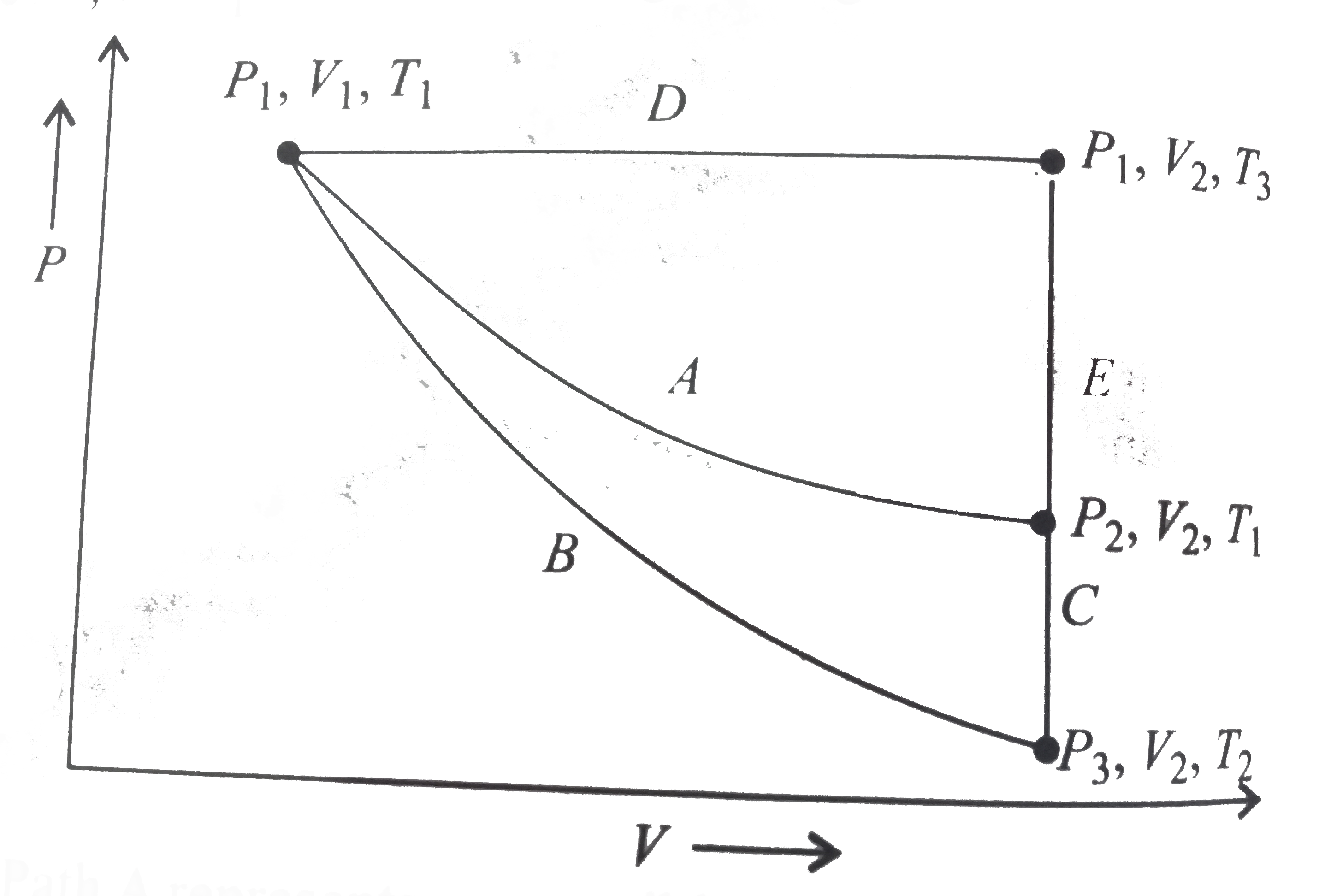The compressibility factor (Z) of a gas at critical state is
(Te=8a27Rb,pe=a27b2,Ve=3b)Solution in Telugu
83
1
38
0.5
The correct Answer is:C
Given , Tc=8a27Rb ,
pc=a27b2,Vc=3b
∵Compressibility factor (Z)=pVRT
(Z)=[a27b2]×[3b]×[R.27bR.8a]
Z=38
Hence, option (C) is the correct answer .
Topper's Solved these Questions
Similar Questions
In the Millikan's oil drop method, which of the following force does not act on the oil drop?
08:58View SolutionCompressibility factor Z=(PV)/(RT) . Considering ideal gas, real gas, and gases at critical state, answer the following questions: The compressibility factor of a real gas is
08:58View SolutionCompressibility factor Z=(PV)/(RT) . Considering ideal gas, real gas, and gases at critical state, answer the following questions: Z_(c) at T_(c) , P_(c) , and V_(c) is
05:14View SolutionFor an ideal gas, an illustratio of three different paths A(B+C) and (D+E) from an initial state P1,V1,T1 to a final state P2,V2,T1 is shown in the given figure.

Path Arepresents a reversible isothermal expansion form P1,V1 to P2,V2, Path (B+C) represents a reversible adiabatic expansion (B) from P1,V1,T1→P3,V2,T2 followed by reversible heating the gas at constant volume (C)from P3,V2,T2 to P2,V2,T1. Path (D+E) represents a reversible expansion at constant pressure P1(D) from P1,V1,T1 to P1,V2,T3 followed by a reversible cooling at constant volume V2(E) from P1,V2,T3→P2,V2,T1.
What is qrev, for path (A)?03:49View SolutionFor an ideal gas, an illustratio of three different paths A(B+C) and (D+E) from an initial state P1,V1,T1 to a final state P2,V2,T1 is shown in the given figure.

Path Arepresents a reversible isothermal expansion form P1,V1 to P2,V2, Path (B+C) represents a reversible adiabatic expansion (B) from P1,V1,T1→P3,V2,T2 followed by reversible heating the gas at constant volume (C)from P3,V2,T2 to P2,V2,T1. Path (D+E) represents a reversible expansion at constant pressure P1(D) from P1,V1,T1 to P1,V2,T3 followed by a reversible cooling at constant volume V2(E) from P1,V2,T3→P2,V2,T1.
What is ΔS for path A?04:03View SolutionFor an ideal gas, an illustratio of three different paths A(B+C) and (D+E) from an initial state P1,V1,T1 to a final state P2,V2,T1 is shown in the given figure.

Path Arepresents a reversible isothermal expansion form P1,V1 to P2,V2, Path (B+C) represents a reversible adiabatic expansion (B) from P1,V1,T1→P3,V2,T2 followed by reversible heating the gas at constant volume (C)from P3,V2,T2 to P2,V2,T1. Path (D+E) represents a reversible expansion at constant pressure P1(D) from P1,V1,T1 to P1,V2,T3 followed by a reversible cooling at constant volume V2(E) from P1,V2,T3→P2,V2,T1.
What is qrev, for path (D+E)?04:41View SolutionFor an ideal gas, an illustratio of three different paths A(B+C) and (D+E) from an initial state P_(1), V_(1), T_(1) to a final state P_(2), V_(2),T_(1) is shown in the given figure. Path A represents a reversible isothermal expansion form P_(1),V_(1) to P_(2),V_(2) , Path (B+C) represents a reversible adiabatic expansion (B) from P_(1),V_(1),T_(1)to P_(3),V_(2),T_(2) followed by reversible heating the gas at constant volume (C) from P_(3),V_(2),T_(2) to P_(2),V_(2),T_(1) . Path (D+E) represents a reversible expansion at constant pressure P_(1)(D) from P_(1),V_(1),T_(1) to P_(1),V_(2),T_(3) followed by a reversible cooling at constant volume V_(2)(E) from P_(1),V_(2),T_(3) to P_(2),V_(2),T_(1) . What is DeltaS for path (D +E) ?
01:52View SolutionThe numerical valuse of Pc,Vc,Tc are
a27b2,3b,8a27Rb respectively
The compressibility factor Z at critical condintions is 38 .02:14View SolutionAssertion: The numerical values of P_(c ), V_(c ) and T_(c ) are (a)/(27b^(2)), 3b and (8 a)/(27 Rb) respectively. Reason: The compressibility factor Z at critical conditions is 3//8
View SolutionFor an ideal monoatomic gas, an illustration of three different paths A,(B+C) and (D+E) from an initial state P1,V1,T1 to a final state P2,V2,T1 is shown in the given figure .

Path A represents a reversible isothermal from P1V1 to P2,V2, path (B+C) represent a reversible adiabatic expansion (B) from P1,V1,T1 to P3,V2,T2 followed by reversible heating of the gas at constant volume (C) from P3,V2,T2 to P2,V2,T1. Path (D+E) represents a reversible expansion at constant pressure P1(D) from P1,V1,T1 to P1,V2,T3 followed by a reversible cooling at constant volume V2(E) form P1,V2,T3 to P2,V2,T1
What is ΔS for (D+E)?03:45View SolutionDefine critical pressure (Pe)
01:16View SolutionCritical constants are related with van der waals' constant as follows: V_( c) = 3b, P_( c) =a/(27b^(2)), T_( c) =(8a)/(27 Rb) The pressure required to liquefy a gas at the critical temperature is called :
01:44View SolutionCompressibility factor under critical state of a gas is
01:40View SolutionCompressibility factor Z=PVRT. Considering ideal gas, real gas, and gases at critical state, answer the following questions:
Zc at Tc, Pc, and Vc is04:01View SolutionFor an ideal gas, an illustration of three different paths A,(B+C) and (D+E) from an initial state P1,V1,T1 to a final state P2,V2,T1 is shown in the given figure.

Path Arepresents a reversible isothermal expansion form P1,V1 to P2,V2, Path (B+C) represents a reversible adiabatic expansion (B) from P1,V1,T1→P3,V2,T2 followed by reversible heating the gas at constant volume (C)from P3,V2,T2 to P2,V2,T1. Path (D+E) represents a reversible expansion at constant pressure P1(D) from P1,V1,T1 to P1,V2,T3 followed by a reversible cooling at constant volume V2(E) from P1,V2,T3→P2,V2,T1.
What is qrev, for path A?05:41View Solution

